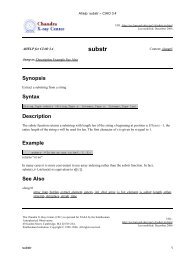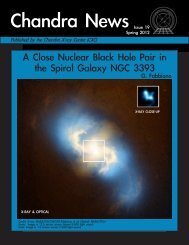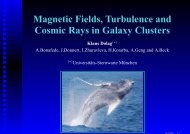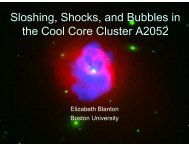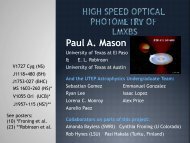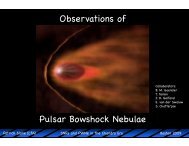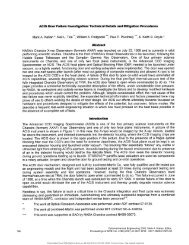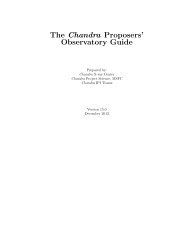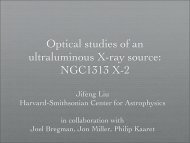Paper Title - Chandra X-Ray Observatory (CXC)
Paper Title - Chandra X-Ray Observatory (CXC)
Paper Title - Chandra X-Ray Observatory (CXC)
Create successful ePaper yourself
Turn your PDF publications into a flip-book with our unique Google optimized e-Paper software.
grating arrays (OTGs) which can be flipped into the path of the X-rays to provide spectroscopy data. The<br />
SIs are sensitive detectors and susceptible to damage from the radiation environment. Therefore an onboard<br />
radiation sensor, EPHIN, is used to detect elevated radiation rates and stow the instruments when<br />
rates reach pre-determined levels. ACIS and HRC are located on the Science Instrument Module (SIM),<br />
which is translated to position the specified instrument at the focal point and also provides focus<br />
adjustments. Each observation requires a specific instrument, translation position, focus position and<br />
grating, each of which is specified in a strictly formatted Observation Request (OR).<br />
The OR also specifies the<br />
precise location of the<br />
observation target so that<br />
the observatory can be<br />
slewed to the correct<br />
position. Pointing of the<br />
observatory is provided by<br />
the Pointing Control and<br />
Aspect Determination<br />
(PCAD) subsystem. The<br />
PCAD subsystem system<br />
has gyros, an aspect<br />
camera, sun sensors, and<br />
reaction wheels to monitor<br />
and control where the<br />
telescope is pointing at any<br />
given moment. During<br />
observations the Aspect Fig. 1. <strong>Chandra</strong> Spacecraft<br />
Camera Assembly (ACA)<br />
is used to track stars and fiducial lights (point sources fixed in the spacecraft body frame), which are used<br />
to provide a highly accurate pointing solution. The reaction wheels are used to orient the vehicle, maintain<br />
pointing and store accumulated angular momentum. Small thrusters are used to unload angular momentum<br />
from the reaction wheels as required. Gyros provide spacecraft rate data which is used to control the<br />
motion of the vehicle. The sun sensors provide <strong>Chandra</strong> with autonomous pointing control capability,<br />
which, when particular faults are detected, will bring <strong>Chandra</strong> to a safe attitude.<br />
A spacecraft cannot operate without power, and <strong>Chandra</strong>'s electrical power comes from two solar array<br />
wings. The energy generated is distributed by the Electrical Power Subsystem (EPS), which also provides<br />
three banks of batteries to provide power during eclipses. <strong>Chandra</strong> goes through two earth eclipse seasons<br />
annually and also experiences occasional lunar eclipses.<br />
To keep the instruments and spacecraft components operating correctly and the telescope alignment<br />
sufficiently accurate, temperatures on <strong>Chandra</strong> must be well controlled. The thermal subsystem uses<br />
several of methods to provide this control. Cooling radiators, insulation, heaters, thermostats, and reflective<br />
surfaces are used to keep each component within its specified thermal limits. As the spacecraft has aged<br />
the efficacy of the multi-layer insulation (MLI) for keeping unit temperatures stable and within limits has<br />
degraded. More specifically, the sun-side of the vehicle has warmed over time, causing exposed units on<br />
the sun side to near or exceed their maximum operating temperatures. To control temperatures, the sun<br />
exposure of these units must be limited. As the angle between the Sun and the spacecraft changes units<br />
receive more or less direct sunlight, depending on their position. So thermal control of several units on<br />
<strong>Chandra</strong> is now closely tied to sun angle.<br />
Linking all of these subsystems and components together is the communications, control, and data<br />
management (CCDM) system. It provides transmit and receive capability through two low gain antennas,<br />
receives and processes commands from the ground and from the on-board computer (OBC), collects and<br />
distributes measurements from sensors, and stores data to two solid state recorders (SSRs). The Deep<br />
Space Network (DSN) is used to communicate with <strong>Chandra</strong>. Generally three one-hour tracks a day



